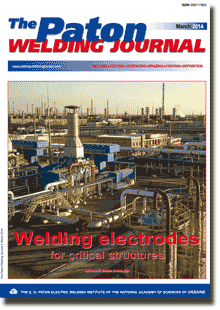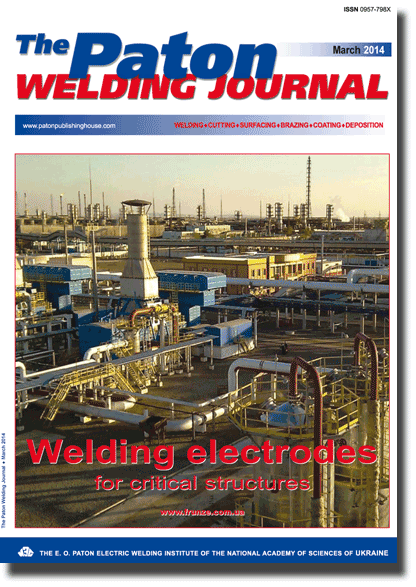| 2014 №03 (09) |
DOI of Article 10.15407/tpwj2014.03.01 |
2014 №03 (02) |

The Paton Welding Journal, 2014, #3, 2-10 pages
NUMERICAL MODELING AND PREDICTION OF WELD MICROSTRUCTURE IN HIGH-STRENGTH STEEL WELDING (REVIEW)
D.Yu. ERMOLENKO and V.V. GOLOVKO
E.O. Paton Electric Welding Institute, NASU. 11 Bozhenko Str., 03680, Kiev, Ukraine. E-mail: office@paton.kiev.ua
Abstract
Analysis of state-of-the-art of problems of numerical modeling and prediction of weld metal microstructure in high-strength low-alloyed steels was performed. Modern approaches to computer modeling of weld microstructure are analyzed from the viewpoint of prediction of weld metal microstructure and properties, taking into account the influence of nonmetallic inclusions on them. General principles of the problem of modeling the process of formation and evolution of nonmetallic inclusions in the weld metal are considered. Thermodynamic approach to prediction of weld metal microstructure and its drawbacks are presented. Features of modeling the process of metal solidification in the weld pool have been analyzed. Theoretical models of dendrite growth by Ivantsov and KGT-theory are noted; limitations of analytical modeling are described. Critical analysis of numerical models of dendrite solidification has been performed. A conclusion was made that the most adequate and experimentally substantiated results of dendrite growth modeling, allowing for nonmetallic inclusion influence, are to be expected from the method of cellular automation, which should be modified allowing for the capabilities of analytical and numerical models. Such an approach is based to computational simplicity and no need for determination of a number of physical constants for real materials. 53 Ref., 3 Figures.
Keywords: weld, microstructure, primary structure, dendrites, nonmetallic inclusions, numerical modeling, microstructure prediction
Received: 22.11.13
Published: 28.03.14
References
- David, S.A., Babu, S.S., Vitek, J.M. (2001) Recent advances in modeling and characterization of weld microstructure. Sci. and Techn. of Welding and Joining, 6(6), 341-346. https://doi.org/10.1179/stw.2001.6.6.341
- Santella, M.L., Babu, S.S., Riemir, B. et al. (1999) Trends in welding research. In: Proc. of 5th Int.Conf.MaterialsPark: ASM Int., 605-609. Grong, O. (1997) Metallurgical modeling of welding. London: TIM.
- Joensson, P.G., Szekely, J., Choo, R.T.T. et al. (1994) Mathematical models of transport phenomena associated with arc-welding processes: A survey. Modeling and Simulation in Material Sci. and Eng., 2, 995-1016. https://doi.org/10.1088/0965-0393/2/5/005
- Evans, G.M., Bailey, N. (1997) Metallurgy of basic weld metal. Abington: Woodhead Publ. https://doi.org/10.1533/9781845698850
- Kluken, A.O., Grong, O. (1989) Mechanisms of inclusion formation in Al-Ti-Si-Mn deoxidized steel weld metals. Metallurg. Transact. A, 20, 1335-1349. https://doi.org/10.1007/BF02665492
- Hseih, K.C., Babu, S.S., Vitek, J.M. et al. (1996) Calculation of inclusion formation in low alloy steel welds. Mat. Sci. Eng. A, 215, 84-91. https://doi.org/10.1016/0921-5093(96)10370-1
- Koseki, T., Ohkita, S., Yurioka, N. (1997) Thermodynamic study of inclusion formation in low alloy steel weld metals. Sci. and Techn. of Welding and Joining, 2, 65-69. https://doi.org/10.1179/stw.1997.2.2.65
- Babu, S.S., David, S.A., Vitek, J.M. et al. (1995) Development of macro- and microstructures of C-Mn low alloy steel welds - inclusion formation. Mat. Sci. and Techn., 11, 186-199. https://doi.org/10.1179/mst.1995.11.2.186
- Babu, S.S., Raidebach, F., David, S.A. et al. (1999) Effect of high-energy-density welding processes on inclusion and microstructure formation in steel welds. Sci. and Techn. of Welding and Joining, 4, 63-73. https://doi.org/10.1179/136217199101537581
- Manson, P. (2012) Program AIDS in modeling welding thermodynamics. Welding J., 12, 28-30.
- Andersson, J.O., Helander, T., Hoeglund, L. et al. (2002) Thermo-calc and DICTRA, computational tools for materials science. CALPHAD., 26, 273-312. https://doi.org/10.1016/S0364-5916(02)00037-8
- Babu, S.S. (2009) Thermodynamic and kinetic models for describing microstructure evolution during joining of metals and alloys. Int. Mat. Rev., 54(6), 333-367. https://doi.org/10.1179/095066009X12506720908654
- Babu, S.S., Vitek, J.M., Iskander, Y.S. et al. (1997) New model for prediction of ferrite number of stainless steel welds. Sci. and Techn. of Welding and Joining, 2(6), 279-285. https://doi.org/10.1179/stw.1997.2.6.279
- Vitek, J.M., Iskander, Y.S., Oblow, E.M. (2000) Improved ferrite number prediction in stainless steel arc welds using artificial neural networks. Pt 1: Neural network development. Welding J., 79(2), 33-46.
- Bhadeshia, H.K.D.H., Svensson, L.E., Gretoff, B.A. (1985) A model for the development of microstructure in low-alloy steel (Fe-Mn-Si-C) weld deposits. Acta Metall., 33, 1271-1283. https://doi.org/10.1016/0001-6160(85)90238-X
- Ion, J.C., Easterling, K.E., Ashby, M.F. (1984) A second report on diagrams of microstructure and hardness for heat-affected zones in welds. Ibid., 32(11), 1949-1962. https://doi.org/10.1016/0001-6160(84)90176-7
- Kasuya, T., Yurioka, N. (1993) Carbon equivalent and multiplying factor for hardenability of steel. Welding J., 72, 263-268.
- Smallman, R.E., Bishop, R.J. (1999) Modern physical metallurgy and materials engineering. Oxford: Butterworth-Heinemann Publ.
- Pavlyk, V. (2004) Modeling and direct numerical simulation of dendritic structures under solidification conditions during fusion welding. Aachen: Shaker.
- David, S.A., Babu, S.S., Vitek, J.M. (2003) Welding: Solidification and microstructure. http:// www.tms.org/pubs/journals/JOM/0306/David-0 306.html
- Trivedi, R., Kurz, W. (1994) Dendritic growth. Int. Mat. Rev., 39(2), 47-74. https://doi.org/10.1179/imr.1994.39.2.49
- Kurz, W., Giovanola, B., Trivedi, R. (1986) Theory of microstructure development during rapid solidification. Acta Metall., 34(5), 823-830. https://doi.org/10.1016/0001-6160(86)90056-8
- McCartney, D.G., Hunt, J.D. (1984) A numerical finite difference model of steady state cellular and dendritic growth. Metallurg. Transact. A, 15, 983-994. https://doi.org/10.1007/BF02644690
- Brown, S.G.R., Williams, T., Spittle, J.A. (1994) A cellular automaton model of the steady-state «free» growth of a non-isothermal dendrite. Acta Metall. et Mat., 42(8), 2893-2898. https://doi.org/10.1016/0956-7151(94)90230-5
- Sasikumar, R., Sreenivasan, R. (1994) 2-dimensional simulation of dendrite morphology. Ibid., 2(7), 2381-2386.
- Tiaden, J., Grafe, U. (1999) A phase-field model for diffusion and curvature controlled phase transformations in steels. In: Proc. of Int. Conf. on Solid-Solid Phase Transformations (Kyoto, Japan, 1999), 737-740.
- Koseki, T. (2001) Solidification and solidification structure control of weld metals. Welding Int., 16(5), 347-365. https://doi.org/10.2207/qjjws1943.70.5_579
- Tiller, W.A., Jackson, K.A., Rutter, J.W. et al. (1953) The redistribution of solute atoms during the solidification of metals. Acta Metall., 1, 428-437. https://doi.org/10.1016/0001-6160(53)90126-6
- Mullins, W.W., Sekerka, R.F. (1964) Stability of a planar interface during solidification of a dilute binary alloy. J. Appl. Phys., 35(2), 444-451. https://doi.org/10.1063/1.1713333
- Ivantsov, G.P. (1947) Temperature field around spherical, cylindrical and needle-like crystal growing in supercooled melt. Doklady AN SSSR, 58(4), 567-569.
- Temkin, D.E. (1960) On rate of crystal needle growing in supercooled melt. Ibid., 132(6), 1307-1310.
- Trivedi, R. (1970) Growth of dendritic needles from a supercooled melt. Acta Metall., 18(3), 287-296. https://doi.org/10.1016/0001-6160(70)90143-4
- Huang, H.C., Glicksman, M.E. (1981) Fundamentals of dendritic solidification: Steady-state tip growth. Ibid., 29, 701-715.
- Langer, J.S., Mueller-Krumbhaar, H. (1977) Stability effects in dendritic crystal growth. J. Crystal Growth, 42, 11-14. https://doi.org/10.1016/0022-0248(77)90171-3
- Kurz, W., Fisher, D.J. (1992) Fundementals of solidification. TransTech Publ.
- Gandin, Ch.-A., Rappaz, M. (1994) A coupled finite element-cellular automaton model for the prediction of dendritic grain structures in solidification processes. Acta Metall., 42(7), 2233-2246. https://doi.org/10.1016/0956-7151(94)90302-6
- Ploshikhin, V.V., Bergmann, H.W. (2001) Correlation between the welding parameters and the grain structure for the fast moving high power line heat source in a thin plate. In: Mathematical modeling of weld phenomena 5. London: IOM Commun., 269-281.
- Hunt, J.D., McCartney, D.G. (1987) Numerical finite difference model for steady state cellular array growth. Acta Metall., 35, 89-99. https://doi.org/10.1016/0001-6160(87)90216-1
- Lu, S.L., Hunt, J.D. (1992) A numerical analysis of dendritic and cellular array growth: The spacing adjustment mechanisms. J. Crystal Growth, 123, 17-34. https://doi.org/10.1016/0022-0248(92)90006-5
- Hunt, J.D., Lu, S.L. (1996) Numerical modeling of cellular/dendritic array growth: Spacing and structure predictions. Metallurg. and Mat. Transact. A, 27(3), 611-623. https://doi.org/10.1007/BF02648950
- Spittle, J.A., Brown, S.G.R. (1994) A 3D cellular automaton model of coupled growth in two component systems. Acta Metall. et Mat., 42(6), 1811-1815. https://doi.org/10.1016/0956-7151(94)90006-X
- Dilthey, U., Reichel, T., Pavlik, V. (1997) A modified cellular automaton model for grain growth simulation. In: Mathematical modeling of weld phenomena 3. London: Maney Publ., 106-113.
- Kurien, L., Sasikumar, R. (1996) Simulation of dendrite morphology in the presence of particles. Acta Metall., 44(8), 3385-3395. https://doi.org/10.1016/1359-6454(95)00439-4
- Sasikumar, R., Jacob, E., George, B. (1998) Simulation of dendrite growth in binary alloys. Scripta Mat., 38(4), 693-701. https://doi.org/10.1016/S1359-6462(97)00501-0
- Galenko, P.K., Krivilev, M.D. (2000) Isothermal growth of crystals in supercooled binary alloys. Mat. Modelirovanie, 12(11), 17-37.
- Galenko, P.K., Krivilev, M.D. (2000) Finite-difference scheme for modeling of crystal structure formation in supercooled binary alloys. Ibid., 12(12), 11-23.
- Krivilev, M.D., Galenko, P.K. (2008) Modeling of transition to diffusionless solidification in high-speed crystallization of binary alloys. Vestnik UdmurtGU, 1, 129-140.
- Krivilev, M.D., Galenko, P.K. (1999) Software complex for modeling of crystal structure formation in supercooled binary alloys: Manual. Izhevsk: UdmurtGU.
- Zhang, Y. (2012) Phase field modeling of dendritic growth and coarsening supercooling. http://www. intechopen.com/ books/supercoo-ling/phase-field-modeling-of-dendritegrowth
- Lebedev, V.G., Danilov, D.A., Galenko, P.K. (2010) On equations of phase field model for non-isothermal kinetics of transformations in multicomponent and multiphase system. Vestnik UdmurtGU, 1, 26-33.
- Steinbach, I., Pezzolla, F., Nestler, B. et al. (1996) Phase field concept for multiphase systems. Physica D: Nonlinear Phenomena, 94(3), 135-147. https://doi.org/10.1016/0167-2789(95)00298-7
- Kobayashi, R.A. (1994) A numerical approach to three-dimensional dendritic solidification. Exp. Mathematics, 3, 410-423. https://doi.org/10.1080/10586458.1994.10504577
Suggested Citation
D.Yu. ERMOLENKO and V.V. GOLOVKO (2014) NUMERICAL MODELING AND PREDICTION OF WELD MICROSTRUCTURE IN HIGH-STRENGTH STEEL WELDING (REVIEW). The Paton Welding J., 03, 2-10.The cost of subscription/purchase order journals or individual articles
| Journal/Currency | Annual Set | 1 issue printed |
1 issue |
one article |
| TPWJ/USD | 384 $ | 32 $ | 26 $ | 13 $ |
| TPWJ/EUR | 348 € | 29 € | 24 € | 12 € |
| TPWJ/UAH | 7200 UAH | 600 UAH | 600 UAH | 280 UAH |
| AS/UAH | 1800 UAH | 300 UAH | 300 UAH | 150 UAH |
| AS/USD | 192 $ | 32 $ | 26 $ | 13 $ |
| AS/EUR | 180 € | 30 € | 25 € | 12 € |
| SEM/UAH | 1200 UAH | 300 UAH | 300 UAH | 150 UAH |
| SEM/USD | 128 $ | 32 $ | 26 $ | 13 $ |
| SEM/EUR | 120 € | 30 € | 25 € | 12 € |
| TDNK/UAH | 1200 UAH | 300 UAH | 300 UAH | 150 UAH |
| TDNK/USD | 128 $ | 32 $ | 26 $ | 13 $ |
| TDNK/EUR | 120 € | 30 € | 25 € | 15 € |
AS = «Automatic Welding» - 6 issues per year;
TPWJ = «PATON WELDING JOURNAL» - 12 issues per year;
SEM = «Electrometallurgy Today» - 4 issues per year;
TDNK = «Technical Diagnostics and Non-Destructive Testing» - 4 issues per year.


